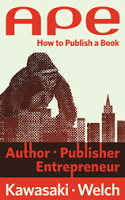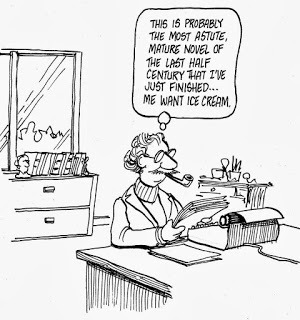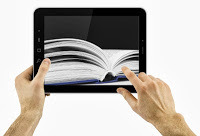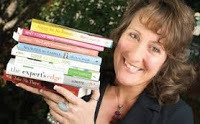Tony Eldridge's Blog, page 3
October 20, 2013
Getting More Out of Amazon: Hot Tip to Increase Traffic
When it comes to Amazon, there are a lot of little hacks you can perform to make your page sell more books. For example, having a keyword-heavy URL will get more visitors to your Amazon page. Learn how you can unearth the right URL and then use that url to get more people to go to your Amazon book page!








Published on October 20, 2013 20:44
October 17, 2013
How to Avoid the Self-Published Look - Part 4
The fifth sign of self-publishing is a crude and simplistic interior design. This primarily applies to the print version of your book because readers can override the interior design of ebooks. Here's how to avoid interior-design signs of self-publishing:
* Fonts. Use a font besides Times New Roman, Arial, or Helvetica. Don't go crazy with a fancy font, but show a little style.

* Blank pages. Remove headings and page numbers on blank pages.
* Line breaks. Ensure that line breaks do not cause hyphenated words in headings and chapter titles.
* Chapter-title pages. Provide ample space on chapter-title pages. Reserve the top half of a page for the title and start the first paragraph about halfway down the first page. Page numbers are either omitted or in a different location on these special pages.
* Page numbers. List page numbers in the top 0.25 inch of your pages, aligned away from the spine, plus the correct running head (see below).
* Running heads. Show the book title in the left-hand page header and the current chapter title in the right-hand page header. For fiction writers, it's customary to show your name in the left-hand page header and the book title in the right-hand page header.
Summary
If you've come this far, you've invested many hours in your book. Don't blow it now. The whole point of self-publishing is to produce a book faster, better, and cheaper than a traditional publisher. These ways of avoiding the "self-published" look are simple and easy, and they increase the attractiveness, professionalism, and marketability of your book.

Guy Kawasaki has written 12 books, 10 of which were traditionally published. His newest book is APE: Author, Publisher, Entrepreneur - How to Publish a Book, which helps people understand how and why to self-publish.
APE: Author, Publisher, Entrepreneur - How to Publish a Book, by Guy Kawasaki and Shawn Welch, is available as an eBook ($9.99) and in paperback ($24.99). Visit http://apethebook.com/








Published on October 17, 2013 22:32
October 14, 2013
Audio Book Available Now: The Samson Effect
Marketing Tips for Authors founder Tony Eldridge has some great news: The Samson Effect is now available on Audible.com.

Read by professional narrator Joe Cirillo, the Samson Effect is the story of Dr. Michael Sieff and Dr. Thomas Hamilton, who have stumbled onto a finding so astonishing that it could reshape the political and religious boundaries of the world.
Hidden in a cave in Hebron, Israel they find an ancient scroll that gives evidence of a substance so powerful, it gave the Biblical strong man Samson his great strength. In the quest to uncover this powerful secret, they run into two other groups who also know of its existance. The first is a group of protectors chosen each generation to keep the ancient secret and use it when the moment is ready.
Get your copy today: http://t.co/PbQ5mEMZis








Published on October 14, 2013 12:43
October 13, 2013
How to Avoid the Self-Published Look - Part 3
Gaffes
The fourth sign of self-publishing is
gaffes-unintentional mistakes that cause embarrassment. It's easy for
self-publishers to make these gaffes because editing, particularly copyediting,
is a different skill from writing. Here are the most common gaffes:
* Widows. Three
main types of widows exist. (1) Widowed text is when the last line of a
paragraph appears on the following page or in the next column. (2) A widowed
heading occurs when a heading is on one page and the following text is on the
next page or in the next column. (3) A widowed bullet occurs when one bullet is
on a page and the subsequent bullets are on the next page or in the next
column.

* Orphans. There
are three kinds of orphans: (1) The first line of text in a paragraph is
separated from the rest of the paragraph on the following page or next column;
(2) A word or part of a word that is not long enough to clear the indent of the
following paragraph is by itself on the last line of a paragraph (usually any
word less than four characters); (3) Your book after your traditional publisher
has given up on it, but I digress.
Widows and orphans are unavoidable in ebooks
because people can adjust the font size and this changes the page layout. Don't
focus on these issues for your ebooks, but if you print your book on paper or a
static PDF, you must pay attention to them.
* Passive voice. The
passive voice is weak, vague, and wordy. "New York publishers are being
attacked by self-publishers" is not as powerful as "Self-publishers
are attacking New York publishers." I search for every instance of
"be" and "being" to eliminate as many instances of the
passive voice as I can. Word's grammar checker can also help you spot passive
sentences.
* Lack of consistency. Ensure
that the voice and design elements of your book are consistent. Here are three
examples. First, as we mentioned earlier, in this book "I" always
refers to me, Guy. Shawn is always mentioned in the third person.
"We" refers to our combined opinion and expertise.
Second, bulleted lists should maintain a parallel structure. If one starts with
a noun, they should all start with a noun. If one starts with a verb, they
should all start with a verb.
Third, consistency also applies to design. For example, in the print version of APE,
when a new section starts, the section title is always on the
next right-hand page, even if this creates a blank page to the left. Similarly,
the first chapter after a new section always starts on the next
right-hand page, always leaving the page on the back of the
section title blank.
* Excessive adjectives and
adverbs. These forms of speech are often overrated, overused, and vague.
How dark was the night? So dark that you couldn't see your hand in front of
your face? How slowly did he walk? Perhaps a toddler could move faster? How
much did you really miss your mother? Maybe enough to make you cry at night?
Find more concrete ways to describe things.
Metaphors and similes beat the crap out of adjectives and adverbs, so use them
when you can. For example, rather than saying, "Hockey is very
violent," you could say, "Hockey is war on ice."
* Lack of guideposts. This
recommendation and the next one are for nonfiction writers. Use subheads to
help your readers navigate sections of a chapter. The name of the chapter is
not enough in nonfiction books because so much material is in each chapter.
Real authors use subheads.
* Long passages of text. A
bulleted list (like this one) is a sign of an organized mind. Rather than
making your reader dig through long passages of text, use bulleted lists to
highlight what is most important. Lists also make great back cover copy for
your printed versions.
A great book that explains these kinds of gaffes and more is The Mac Is
Not a Typewriter by my lovely friend Robin Williams. Also, you can't
go wrong with The Chicago Manual of Style, and the Purdue Online
Writing Lab http://owl.english.purdue.edu/owl/.

Guy Kawasaki has written 12
books, 10 of which were traditionally published. His newest book is APE:
Author, Publisher, Entrepreneur - How to Publish a Book, which helps people
understand how and why to self-publish.
APE: Author, Publisher, Entrepreneur - How to Publish a Book, by Guy Kawasaki
and Shawn Welch, is available as an eBook ($9.99) and in paperback ($24.99).
Visit http://apethebook.com/








Published on October 13, 2013 18:05
October 10, 2013
Google+ and SEO: What You Must Know About Online Search
Does Google+ really matter when it comes to online search? SEO expert Matt Beswick separates myth from fact in this video: Is Google+ Really Mandatory for Search?








Published on October 10, 2013 20:17
October 6, 2013
How to Avoid the Self-Published Look - Part 2
Gaffes
The fourth sign of self-publishing is gaffes-unintentional mistakes that cause embarrassment. It's easy for self-publishers to make these gaffes because editing, particularly copyediting, is a different skill from writing. Here are the most common gaffes:

* Improperly capitalizing the title and subtitle. Use headline-style capitalization for titles and subtitles. This means capitalizing the first word, last word, and every noun, pronoun, verb, adjective, and adverb. Start articles, prepositions shorter than five letters, and conjunctions with lowercase letters. Contrary to popular belief, headline style does not mean lowercasing all "small" words. Some small words are verbs ("Is," "Are," and "Be" are prime examples) or other parts of speech aside from prepositions.
Follow these rules for your title page, book listing, and cover. During the production of What the Plus!-Google+ for the Rest of Us, we didn't realize that the cover said "Google+ for the rest of us" (sentence caps, not title caps). We had to change this and re-export all of our ebook files with a new cover.
* Omitting the serial comma. A serial comma (or Oxford comma, as they say across the pond) prevents confusion when you are listing several items. For example, the probably apocryphal book dedication "To my parents, Ayn Rand and God" implies that the person's parents were Ayn Rand and God (that's quite the couple!).
Then there is the TV listing of The Times: " http://itre.cis.upenn.edu/~myl/languagelog/archives/002932.html of his [Peter Ustinov's] global tour include encounters with Nelson Mandela, an 800-year-old demigod and a dildo collector." (There must be more than one Nelson Mandela!)
The addition of a serial comma makes the meaning of the phrases clear. The dedication is to three parties: parents, Ayn Rand, and God. Peter Ustinov met with three people in the episode of his television show. I search for every instance of "and" and "or" to ensure that I have not left out any serial commas.
* Improper hyphenation. Hyphenation and compounding words is constantly changing, but violating some rules marks you as a self-publisher. Here are the three main ones: hyphenate two or more words used as an adjective-"social-media sites"; hyphenate compound numbers-"forty-seven"; and hyphenate only between syllables as specified in the dictionary for end-of-line breaks-"enchant-ment."
* Using two spaces between sentences. In the old days of typewriters, characters were the same width, so two spaces were necessary to separate sentences for visual effect. With computers, characters are proportional, so they fit closer to each other, and one space is sufficient. Before you submit your manuscript, search for all double spaces and replace them with single spaces.
You can customize the grammar checker in Word to help you avoid simple issues such as two spaces between sentences. Select "Preferences" from the Word menu and click on the "Spelling and Grammar" icon.
* Dumb apostrophes and quotation marks. There's a world of difference between dumb apostrophes and quotation marks and their "smart" versions.
There are two ways to ensure the correct usage of smart quotes and apostrophes. First, you can turn on a preference in Word to add them automatically. Second, you can type them in.
* Using quotation marks for emphasis. There are three correct ways to use quotation marks. First, they indicate a direct quotation, such as "This is one small step for [a] man, one giant leap for mankind." Second, they act as "scare quotes" to alert readers that a term is used in a nonstandard sense, usually irony or sarcasm. Third, they replace the words "so-called."
One of the most common misuses of quotation marks is to add emphasis. For example, does it make sense for a sign to say All employees must "wash hands" before returning to work?
* Lack of indentation. The first paragraph of a style should be flush left. However, you should indent every subsequent paragraph.
* Underlining. There's bold text and there's italic text, but there's never underline, except as a hyperlink. If you format text with an underline that's not a hyperlink, readers will think your book has a dead link.

Guy Kawasaki has written 12 books, 10 of which were traditionally published. His newest book is APE: Author, Publisher, Entrepreneur - How to Publish a Book, which helps people understand how and why to self-publish.
APE: Author, Publisher, Entrepreneur - How to Publish a Book, by Guy Kawasaki and Shawn Welch, is available as an eBook ($9.99) and in paperback ($24.99). Visit http://apethebook.com/








Published on October 06, 2013 20:27
October 3, 2013
Marketing Tips for Authors Blog Carnival - October 4, 2013
Welcome to the October 4, 2013 edition of marketing tips for
authors. We've got a great mix of tips for social networking, social media,
book marketing, and more. Thank you to all of the contributors.
Author Tips
Iulian Ionescu presents Quick Manuscript Editing Tips posted at Fantasy Scroll
- a blog for fiction writers.

Book Marketing
Bryan Chau presents Turn On Your Search Engines – SEO Strategies posted
at Success
Pen Pal, saying, "SEO, search engines, business, success,
markets, content, advertisements, social media, etc."
JeanNicole Rivers presents Three Things To Know For Success At A Book Fair |
JeanNicole Rivers posted at JeanNicole
Rivers.
Social Media
Kimberley Grabas presents How to Create a Custom Facebook Cover Image That Gets
Noticed (Without Spending a Dime) posted at Your
Writer Platform, saying, "Can’t afford a designer, but have
Facebook cover image envy? Do you want to have an amazing cover photo that
attracts new readers as well as keeps your current fans coming back for more?
Well you’re in luck! As of July 1st, 2013, Facebook has relaxed their
guidelines somewhat, allowing you to add more than just the ’20% text maximum’
to your image, as well as any other info you think may entice your fans to
stick around. Add to that the option to use the free online photo editing
software site known as PicMonkey, and we’re in Facebook-cover-image-making
business!"
Social Networking
Jon Rhodes presents It’s Called “Social” Networking, So Get Social! posted
at Affiliate
Help!, saying, "You can get far more out of social networking
if you actually get social. Find out how."
That concludes this edition. Submit your blog article to the
next edition of marketing tips for authors using our carnival submission form. Past posts and future hosts can
be found on our blog carnival index page.








Published on October 03, 2013 20:39
October 1, 2013
Another Method for Authors to Get More Book Reviews
Are you looking for more book reviews? You might be surprised where opportunities lurk. In this case, we're talking about blog commenting. See how one author doubled review requests just by responding to blog comments. Not only did she get to know some key bloggers, but her book got some additional review requests.
You can learn more about networking on blogs here: http://www.huffingtonpost.com/penny-c-sansevieri/discovery-another-buzzwor_b_3800283.html








Published on October 01, 2013 20:21
September 29, 2013
How to Avoid the Self-Published Look - Part 1
Appearance Is Everything
This chapter helps you avoid publishing a book that looks cheesy, vain, and amateurish. Steve Jobs taught me that little details separate the mediocre from the excellent. The way to avoid the "self-published" look is simple, and it increases the attractiveness, professionalism, and marketability of your book.

The first outward sign that your book is self-published is a crappy cover design. This topic merits a long discussion, so we'll address it in the next chapter.
The first internal sign that your book is self-published is crappy writing, but our writing and editing tips will help you avoid this. Sue Grafton notwithstanding (she did retract her statement http://louisvilleky.com/2012/08/more-from-sue-grafton-on-publishing-indie-writers/ in the epigraph above, but S for Self-Publishing is out of the question), the stigma of self-publishing has diminished. But it still exists, and there's no reason why you can't make your book look like it's professionally published; remember, the goal is artisanal books.
Front Matter
Beyond the cover, the first sign of a self-published printed book is the lack of traditional front matter on the first few pages of your book. We recommend referring to The Chicago Manual of Style http://www.amazon.com/Chicago-Manual-Style-16th-Edition/dp/0226104206 to ensure that your front matter is correct. This thousand-page tome also covers what you need to know about grammar, punctuation, and the mechanics of publishing.
Power tip: You should buy a copy of The Chicago Manual of Style because having one around makes you feel like a real writer, and it impresses people when they see it on your shelf. And you should not hire a copyeditor who doesn't own one.
Ebook Front Matter
When it comes to ebooks, there is a tradeoff between the credibility of traditional front matter and the marketing benefits of facilitating people's ability to "look inside" books on Amazon.
People can see approximately 10 percent of a book this way. Let's say your book is two hundred pages long; people will be able to read the first twenty pages. Do you want to use up your twenty pages on typical front matter? Even if you don't care about the wasted pages, there is no reason to force customers to click five to ten times to get to the good stuff.
This is like a pharmaceutical company running pages of FDA-required warnings and disclaimers ("In the event of an erection lasting more than four hours, seek immediate medical help to avoid long-term injury") before advertising the drug itself. For marketing purposes, a better order for ebook front matter, tradition be damned, is:
* Cover
* Blurbs (more on blurbs below)
* Table of contents
* Foreword or preface (but not both, and neither for fiction)
* Chapter 1
You can stick everything else in the back because most of it doesn't matter to most people. This structure means that prospective readers can garner more information in less time to make a buying decision-which is the goal, after all. Remember: with a physical book, people can skip ahead pages at a time, so you can stick with The Chicago Manual of Style's recommendations. On a website, too many clicks spoil the preview. (Hat-tip: I got this idea from Michael Alvear in his book Make a Killing on Kindle.)
Organization Name
The second sign of self-publishing is that you've named the publishing company after yourself. One hundred years after their start-long after the founders died-names like Alfred A. Knopf, John Wiley, and G. P. Putnam sound prestigious and cool, but the name of your organization needs to sound prestigious and cool before you die.
For example, The Schmoe Way by Joe Schmoe from Schmoe Press doesn't cut it. Using your last name as the publisher's name screams "self-published" and, even worse, "I lack imagination." Pick a street name, a pet's name, a geographical landmark, or your favorite Pokémon character. Then Google your idea to ensure that no one else already uses it.
Anything is better than your last name for your company's name. Nononina Press, the publisher of APE, is the first two letters of my four kids' names.
Blurb Overload
The third sign of self-publishing is an excessive number of testimonial quotes (known as blurbs in the publishing business). Good blurbs are short, sweet, and limited to six. They answer the question "Why should I buy this book?"
A book with more than six blurbs means that the author doth promote too much. This is like PowerPoint slides that try to overwhelm you with text. A better goal is to establish a reputation that is so well known and a topic that is so timely that no blurbs are necessary at all.
We recommend including blurbs in the front matter of your book for two reasons: first, they reinforce the wisdom of purchasing your book. You can never reduce cognitive dissonance too much-even for a $0.99 purchase.
Second, bloggers will often grab blurbs and use them in their review. We recommend putting blurbs on page i or ii to ensure that people see them. This requires pushing everything else back a page, but page count in ebooks is irrelevant, so it isn't a problem.
Blurbs on the thumbnail of the cover are too small to read, and there is no back cover. However, if you publish your book with Kindle Direct Publishing, you can include your blurbs in the online listing of your book.
Guy Kawasaki has written 12 books, 10 of which were traditionally published. His newest book is APE: Author, Publisher, Entrepreneur - How to Publish a Book, which helps people understand how and why to self-publish.
APE: Author, Publisher, Entrepreneur - How to Publish a Book, by Guy Kawasaki and Shawn Welch, is available as an eBook ($9.99) and in paperback ($24.99). Visit http://apethebook.com/









Published on September 29, 2013 20:23
September 26, 2013
How to Sell More Books on Amazon With This Simple Trick
 If you have worked on your Amazon book page, you know you can add photos. But have you considered posting more than just your book cover? You can upload additional photos related to your book's content, too. It's a great method to help your book stand out and captivate readers/buyers. See the examples below for both fiction and nonfiction. It's easy to do, just click on “add images” and upload your photos. Why not get more out of Amazon?
If you have worked on your Amazon book page, you know you can add photos. But have you considered posting more than just your book cover? You can upload additional photos related to your book's content, too. It's a great method to help your book stand out and captivate readers/buyers. See the examples below for both fiction and nonfiction. It's easy to do, just click on “add images” and upload your photos. Why not get more out of Amazon?http://www.amazon.com/Sell-Books-Truckload-Amazon-com-ebook/dp/B00CJ0USL0/ref=cm_cmu_pg__header
Here is an example of a fiction title: http://www.amazon.com/Shelf-Life-Publ...http://www.amazon.com/Shelf-Life-Publicist-Book-ebook/dp/B00FA5EB4Q/ref=tmm_kin_swatch_0?_encoding=UTF8&sr=1-2&qid=1379446200

About the author: Penny C. Sansevieri, CEO and founder of Author Marketing Experts, Inc., is a best-selling author and internationally recognized book marketing and media relations expert. Her company is one of the leaders in the publishing industry and has developed some of the most cutting-edge book marketing campaigns. She is the author of five books, including Book to Bestseller, which has been called the "road map to publishing success." AME is the first marketing and publicity firm to use Internet promotion to its full impact through The Virtual Author Tour™, which strategically works with social networking sites, blogs, Twitter, Pinterest, Linkedin, YouTube, and relevant sites to push an authors message into the virtual community and connect with sites related to the book's topic, positioning the author in his or her market. In the past 24 months their creative marketing strategies have helped land 11 books on the New York Times Bestseller list. To learn more about Penny’s books or her promotional services, you can visit her website at http://www.amarketingexpert.com.








Published on September 26, 2013 21:57



